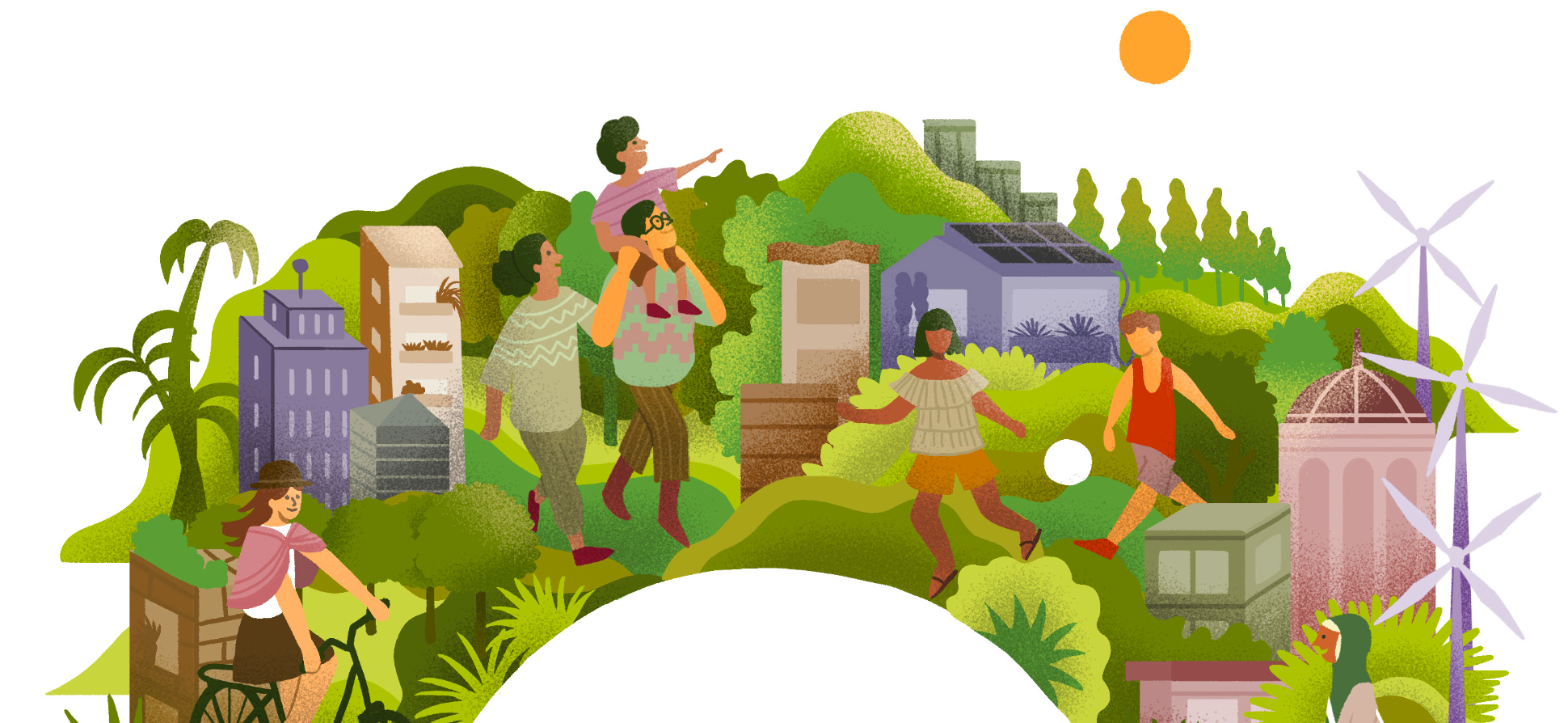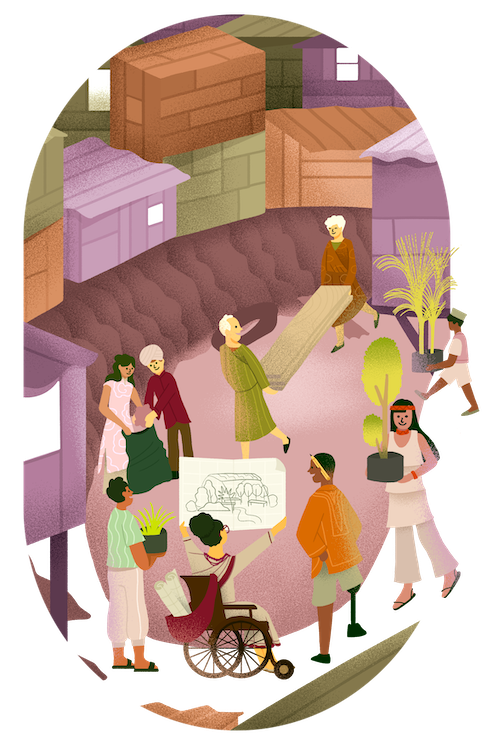World Cities Report 2024

Forewords

António Guterres
"The fight against climate change and the struggle to achieve more sustainable and equitable urbanization are two sides of the same coin. When buildings, homes and vital infrastructure like water and transportation systems are poorly planned, built and managed, they are no match for climate-fueled disasters like rising seas, heatwaves, and other extreme weather impacts. This challenge disproportionately affects the poorest and most vulnerable people.

Anacláudia Rossbach
"With every year, the message has become more urgent as the impact of climate change worsens while concrete action to address it lags far behind. From rising sea levels to urban heat waves, the human, economic and environmental costs are becoming too high—and are only set to increase in future. This report shows that almost no urban resident will be unaffected, with billions of people subjected to hotter temperatures or exposed to the risks of flooding and other threats."
Caution is needed in accelerating climate adaptation and mitigation efforts in cities to avert unintended and exclusionary consequences. When protective disaster infrastructure is constructed in cities, poor households, and those living in informal settlements and slums may find themselves evicted or more exposed if such communities are not factored into the design

Chapter 1

Cities as Hubs for Climate Action
Cities are both victims of climate change and among its worst perpetrators: not only are they disproportionately exposed to its impacts, but they are also responsible for generating a large share of global emissions. This means there is not only a moral imperative to take urgent action at the local level to promote low-carbon, sustainable urbanization, but also a compelling logic. Cities, in fact, are highly conducive to the implementation of adaptation and mitigation programmes that deliver a range of co-benefits to communities in terms of poverty reduction, employment, service provision and quality of life. Already, some of the most exciting and progressive solutions are emerging from cities and communities who in many cases are taking action, in the absence of national and international support, to strengthen their collective resilience. In addition, cities across the world are demonstrating that it is possible to decouple urban development from increasing emissions. Increasingly, then, urban areas are being seen not just as part of the problem, but part of the solution too—even if their full potential has yet to be realized.
Read moreKey Findings
1.Though urbanization continues to be a major source of greenhouse gas emissions, in many contexts urban emissions per capita are now lower than national averages.
2.Rather than regarding them as problems, cities should be seen as key to achieving global climate goals.
3.Even countries with low levels of urbanization can plan and commit to ambitious climate action targets in their cities.
4.Countries that have a higher share of informal housing and employment are more vulnerable to climate change.
Key Messages
- Climate action, as currently implemented in urban areas, does not reflect the urgency of the threat posed by climate change.
- People must be at the centre of any meaningful climate action in cities and human settlements.
- Cities are at the forefront of addressing the challenge of climate change, both in terms of direct mitigation and adaptation efforts and resilience building.
- Aligning climate change adaptation with poverty reduction and disaster risk reduction through community-led settlement upgrading can help build resilience to climate shocks.
Chapter 2

Climate Change and International Development: What Have We Achieved Since the Adoption of the Paris Agreement?
There has been increasing attention focused on the challenge of climate change in recent years, reflected in the passage of the landmark Paris Agreement in 2015 and an array of other development frameworks such as the 2030 Agenda for Sustainable Development and the New Urban Agenda that include specific components addressing its threats. However, the reality on the ground is that the world remains firmly on course to break the agreed ceiling of a 1.5 degree Celsius increase from pre-industrial levels. In part, this failure is the result of continued barriers to action at the local level: cities are still largely excluded from national and international decision-making around resilience building, and lack access to adequate levels of finance to take meaningful action themselves. However, there is evidence that this is beginning to change as awareness grows of the pivotal role cities can play in mounting a unified response to the climate crisis. Recent years have also seen debates on climate justice shift from the global to the local level, with cities beginning to mainstream climate equity considerations into their programmes. Consequently, the various global agendas set in place in recent years offer an important framework to guide and coordinate climate action across a multitude of scales and in different urban contexts.
Read moreKey Findings
1.Though urbanization continues to be a major source of greenhouse gas emissions, in many contexts urban emissions per capita are now lower than national averages.
2.Rather than regarding them as problems, cities should be seen as key to achieving global climate goals.
3.Even countries with low levels of urbanization can plan and commit to ambitious climate action targets in their cities.
4.Countries that have a higher share of informal housing and employment are more vulnerable to climate change.
Key Messages
- Climate action, as currently implemented in urban areas, does not reflect the urgency of the threat posed by climate change.
- People must be at the centre of any meaningful climate action in cities and human settlements.
- Cities are at the forefront of addressing the challenge of climate change, both in terms of direct mitigation and adaptation efforts and resilience building.
- Aligning climate change adaptation with poverty reduction and disaster risk reduction through community-led settlement upgrading can help build resilience to climate shocks.
Chapter 3

Exposure to Climate Related Hazards: Current and Future Trends
This chapter provides a detailed overview of the current and projected exposure facing cities from a variety of climate change impacts: from temperature increase to sea-level rise and riverine flooding. It demonstrates how, even in moderate scenarios, billions of city dwellers could be directly affected as the crisis deepens and widens in the near future. Through adopting a geospatial approach that uses the Degree of Urbanization methodology for defining different urban and rural areas, this chapter shows that virtually no urban inhabitant is unexposed to climate change, even though the impacts will be differentially felt. Importantly, modelling shows that the extent of these challenges will be greatly dependent on the pathways we choose today: the true human and environmental cost will depend to a large extent on whether or not dedicated and proportionate action is taken now. An important first step in making this happen is to develop detailed, multi-dimensional assessments in cities and communities, particularly developing countries and informal settlements where investment in data collection and analysis has often been limited. In this way, cities can develop a clearer picture of current patterns of vulnerability in their territories and tailor their responses accordingly to ensure the most exposed areas are prioritized for protection.
Read moreKey Findings
1.The increasing concentration of people in hazard-prone urban areas means the impact of climate change is increasingly urbanized.
2.Cities are projected to become hotter in future, with almost no inhabitant unaffected in a carbon-intensive scenario.
3.A significant proportion of cities will transition to more arid or humid conditions—the magnitude will depend on different policy choices and emission scenarios.
4.Sea-level rise poses a profound threat to many coastal cities worldwide, creating even greater exposure in areas already vulnerable to flooding.
5.Riverine flooding, while less publicized as an issue than sea-level rise, nevertheless represents a major hazard in many cities.
Key Messages
- Though the projected impacts of climate change on cities appear bleak, better policy choices and effective climate action now have the potential to significantly limit future exposure.
- The urbanization of climate exposure means that strategies to reduce vulnerability must be conceived through an urban lens, placing cities at the centre of climate action.
- Closing the urban exposure and vulnerability data gap is critical for cities to effectively prepare for and respond to climate risks.
- There is a need to move beyond measuring exposure to determining vulnerability through detailed, localized assessments.
Chapter 4

Climate Action and Vulnerable Urban Groups
Though almost all urban residents will be affected to some degree by climate change, its impacts are not distributed evenly. The climate crisis is already interacting with existing patterns of inequality and exclusion, meaning the most marginalized populations—including women, children, migrants, people with disabilities, ethnic minorities and Indigenous Peoples—are disproportionately affected. Currently, urban climate interventions are failing to adequately recognize the specific challenges these groups face. Consequently, millions of urban residents (especially those living in informal settlements) are being excluded from adaptation plans and even negatively impacted by climate interventions that overlook their needs. Cities must therefore ensure they address the social dimensions of vulnerability by promoting community-led interventions, targeted in particular at the most neglected neighbourhoods and incorporating a variety of pro-poor elements such as inclusive service provision and welfare support.
Read moreKey Findings
1.The impacts of the climate crisis are being unleashed in an unprecedented manner on many inter-connected urban systems, including economic, social, ecological and urban infrastructure systems.
2.Urban informality by its nature is a key driver of vulnerability, with slums and informal settlements among the most exposed to disasters and other impacts.
3.Urban informality by its nature is a key driver of vulnerability, with slums and informal settlements among the most exposed to disasters and other impacts.
4.In many cases, current urban adaptation and mitigation efforts are failing to protect the most vulnerable populations from climate change—and even making their situation worse.
5.Existing patterns of urbanization create differential vulnerabilities to climate change.
Key Messages
- Adaptation plans that are co-created with diverse urban groups are more likely to result in inclusive, effective solutions that build the resilience of the most vulnerable to climate shocks.
- Municipal governments should support locally-led climate adaptation to address vulnerability, boost resilience and enhance city-wide climate action.
- Cities should prioritize investing in resilient infrastructure in underserved communities as a basis for building their resilience to climate-induced shocks.
- Strengthening social protection programmes that address climate shocks is critical for building the resilience of vulnerable urban groups.
Chapter 5

Mapping the Solution Space for Climate Action: The Role of Urban Planning and Design
Urban planning and design offer an arsenal of highly effective strategies to improve resilience, yet so far, much of their potential remains untapped. This is despite the many opportunities now available—from the Nationally Determined Contributions and National Urban Policies that have emerged from recent global development agendas, to building codes, zoning and other instruments that can be leveraged at the local level—to promote sustainable, low-carbon development. From renewable energy systems and resource-efficient construction to integrated transport and nature-based solutions, cities have a variety of tools at their disposal to improve resilience and reduce emissions. However, various technical, financial and institutional barriers currently prevent many of these solutions from being enacted. With the right political will at both the national and local level, including adequate funding and expertise to support the development of solutions, cities can work with communities, businesses and other stakeholders to promote compact, integrated and equitable urban fabrics that benefit residents while strengthening resilience.
Read moreKey Findings
1.The last 30 years have witnessed a decline in green spaces in urban areas around the world, a trend that needs to be reversed given its implications for climate.
2.Climate action plans remain absent in many countries and, where they do exist, typically prioritize mitigation over adaptation.
3.Inadequate capacity within local governments and institutional barriers pose obstacles for the development and effective implementation of climate-resilient plans.
4.Climate-resilient planning aligns with the broader principles of inclusive, sustainable urban development.
Key Messages
- Integrating climate action into urban planning and design frameworks is essential for a sustainable future.
- National urban policies should urgently address mitigation and adaptation.
- Urban planning and design should promote localized, context-specific climate solutions.
- Cities should invest in equitably distributed, nature-based solutions.
Chapter 6

Resilient Infrastructure as an Accelerator of Transformative Climate Action in Cities
Urban infrastructure is not only a fundamental element in the prosperity and well-being in cities, but also a key determinant of risk and vulnerability. Urban areas and communities with inadequate infrastructure are likely to be the most affected by extreme weather events associated with climate change. Without sustained, socially inclusive investments in infrastructure, these infrastructural deficits will widen, in the process exposing many more urban residents to potentially catastrophic climate-induced hazards. The fact that much of the infrastructure needed has yet to be built is both a problem and an opportunity: while the scale of action required is daunting, there is also the possibility for cities to correct course and channel resources towards infrastructure that builds resilience. But even more than that, infrastructure can play a transformative role in reshaping the relationships between urban residents and their surroundings in ways that contribute to lasting and climate-resilient development. By embracing innovative and justice-based approaches to infrastructure, including the promotion of green and blue infrastructure alongside conventional “grey” or engineered infrastructure, cities will not only improve the resilience of their infrastructure but also use it as a tool for societal and environmental transformation.
Read moreKey Findings
1.Resilient infrastructure is a critical element of urban climate action to achieve the Sustainable Development Goals, the Paris Agreement, the Sendai Framework and the New Urban Agenda.
2.Infrastructure around the world is already being affected by climate change, and the costs associated with damaged assets, expensive repairs, service disruptions and loss of life are expected to increase.
3.A large share of the urban infrastructure needed to achieve resilience has yet to be built, posing significant challenges but also offering the possibility to build it more sustainably and inclusively.
4.Infrastructure should be designed not only to be resistant to the effects of climate change, but also address the underlying social and environmental factors that contribute to vulnerability.
Key Messages
- Residents should be involved in the planning, design and delivery of low-carbon and resilient infrastructure.
- To ensure infrastructure is climate resistant, but also builds resilience, it is vital to establish systems to fully access the wide range of benefits it will bring.
- Incorporating informality into infrastructure planning and implementation can contribute to equity and resilience in cities.
- Improving and leveraging the network of nature-based infrastructure in cities can serve as a transformative accelerator of climate action.
Chapter 7

Multi-level Governance for Inclusive Climate Action
Cities play a unique role on the frontline of climate change, positioning them to design and deliver locally appropriate solutions in partnership with those most affected by its impacts. In practice, however, their ability to act decisively continues to be undermined by their marginal position both in their countries and on the international stage. Even in supposedly decentralized contexts, local governments frequently lack sufficient authority or resources to lead substantively on climate action. Furthermore, national governments remain the primary arbiter of partnerships and agreements with development agencies and financial institutions, affording limited space for local governments to engage autonomously with global development platforms. The need for stronger and more collaborative multi-level governance applies not only to the vertical architecture linking cities with national and international structures, however, but also the horizontal connections between government actors and other stakeholders including communities and civil society organizations. Ultimately, climate action can achieve far more impact if delivered through an inclusive, integrated approach to governance.
Read moreKey Findings
1.The climate emergency is complex and cannot be effectively tackled by local governments, or any single level of government, alone.
2.There is an urgent need to develop and strengthen the capacities of local and regional governments to implement climate solutions, particularly in developing countries.
3.Cities and regions across the world are increasingly engaging in multilateral initiatives to advocate for stronger climate action.
4.Hybrid governance approaches, characterized by multi-stakeholder and cross-sectoral collaboration, offer a powerful alternative to conventional top-down approaches to climate action.
Key Messages
- Effective climate action requires multi-level governance and collaboration across different scales.
- Increasing local capabilities to facilitate and manage adaptation initiatives is vital.
- Strengthening the co-existence of formal and informal governance systems offers valuable opportunities to accelerate climate action.
- Knowledge transfer should be a two-way process, with an emphasis on scaling up local experiences and best practices.
Chapter 8

Fostering Innovation for Inclusive Climate Action in Cities
Innovation is a crucial catalyst of climate action that cities, with their concentration of knowledge and resources, are especially well placed to cultivate. Importantly, innovation encompasses not only the rollout of “new” or “advanced” inventions, but also the reconfiguration of institutions and systems to achieve positive social and environmental aims. However, it is not the case that innovation is inherently positive: without proper consideration of its wider inequalities and vulnerabilities, it can reinforce existing patterns of exclusion and even create new ones for disadvantaged groups. For cities, the challenge is to reimagine innovation beyond a specific invention, place or creative class, instead facilitating an open and equitable forum for debate, knowledge exchange and collaboration that is inclusive of all residents and their needs. With these conditions in place, cities can achieve far-reaching and transformative outcomes of their existing social and environmental vulnerabilities and injustices.
Read moreKey Findings
1.Cities can accelerate climate action through an integrated process of innovation that supports low-carbon transitions.
2.Integration and coordination across the three domains of innovation—technological, nature-based and social—is necessary to unlock co-benefits and optimize synergies for realizing climate-resilient cities.
3.Innovation can result in adverse outcomes for disadvantaged groups, such as low-income urban residents, if inequalities are overlooked.
4.The influence of the global climate agenda on urban innovation is not well integrated or clearly framed.
Key Messages
- There is an opportunity for national governments during the third revision of Nationally Determined Contributions in 2025 to strengthen their focus on urban innovation.
- Policy and planning at the national level should support inclusive innovation to achieve resilient cities.
- Local governments can actively foster inclusive innovation ecosystems, particularly when tied to local development agendas, to address community needs.
- Public institutions, private sector entities and civil society organizations all have a key role to play in advancing inclusive innovation.
Chapter 9

Financing Interventions for Climate Change in Cities
Despite increasing recognition of their importance in winning the climate battle, cities continue to struggle to access adequate financial resources. Currently, most cities lack sufficient financing to deliver the level of climate action needed to ensure sustainable and climate-resilient urban futures. The reasons for this are complex and wide-ranging, rooted in part in the legal and systemic limitations of local authorities to raise own source revenue, coupled with reduced or irregular disbursements from national governments that are themselves overwhelmed by climate and growing debt challenges. While borrowing is a necessary consideration, cities are generally unable to secure loans or grants from financial institutions, leaving them reliant on national governments to negotiate for these external resources. To change this, cities need to embrace long-term and integrated planning for climate projects, working closely with regional and national governments, as well as local and international financial institutions, to facilitate better financial access for cities. This support should be accompanied by capacity building and technical assistance to ensure local governments have the necessary systems in place to deliver climate action effectively. Local governments can also explore various measures to enhance their own revenue streams and further incentivize other actors, including private enterprises, households and communities, to invest in climate action.
Read moreKey Findings
1.Cities are receiving less than 20 per cent of the finance required for effective climate action and are struggling to attract financing, particularly for small-scale local projects.
2.The growing imbalance between financing adaptation and mitigation has a more severe impact on the effectiveness of climate action at the city level.
3.No single source can deliver the scale and speed of urban climate finance needed.
4.There is significant potential for local governments to scale up land-based revenue sources to finance urban climate action.
5.Reforms to improve access, efficiency, alignment and equity in the international financial systems can enhance the quantity and quality of climate finance available for cities.
Key Messages
- To develop bankable projects, cities need to adopt an integrated approach through stronger vertical and horizontal collaboration.
- Borrowing from private sources and tapping into global climate funds is necessary for cities to close the financing gap, but this must be approached strategically.
- Cities need to enhance their creditworthiness and risk profiles to attract financing at favorable terms, especially from private sources.
- Cities need to leverage a blend of financial sources for urban climate action.
Chapter 10

Building Climate Resilience in Urban Areas
The final chapter looks forward to envision how cities can achieve the transformative change needed to thrive in the face of the climate crisis. While the alarm was raised decades ago on the imminent threats posed by climate change, with UN-Habitat one of many voices calling for urgent action at the local level, the world has yet to see anything close to the required scale of mobilization and investment in response. However, with the right will in place and working together with all stakeholders, including the most marginalized communities, national and local governments can greatly enhance urban resilience while delivering a wider agenda of social inclusion and environmental justice. The more equitable a city is, the better placed it will be to withstand the impacts of climate change and maintain momentum in the coming years.
Read moreKey Findings
1.The intersecting challenges of climate change and urbanization have been on the global development agenda for decades, yet action on the ground is still failing to keep pace with the worsening impacts.
2.Cities are only as resilient as their most vulnerable inhabitants: urban resilience cannot be achieved without putting fairness and equity at the centre of urban climate action.
3.Most of the solutions cities need to respond decisively to climate change are already available.
4.Resilience interventions achieve the greatest impact when they harness local resources and deliver collective benefits, such as infrastructure and service provision.
Key Messages
- Resilience should be negotiated with communities, rather than imposed on them: a negotiated approach to building resilience can open up different perspectives, identify trade-offs and enable the most vulnerable to define what form it should take.
- City authorities should move beyond traditional top-down hierarchies to embrace their role as coordinators, striving to engage a broad range of stakeholders to share responsibility for climate resilience.
- Urban resilience is not a fixed end-point that cities reach through a single prescribed pathway, but rather a horizon to travel towards through incremental steps.
- Rather than focusing on the specific, immediate symptoms of climate change, cities should embrace a more holistic approach that addresses the root causes of vulnerability.

